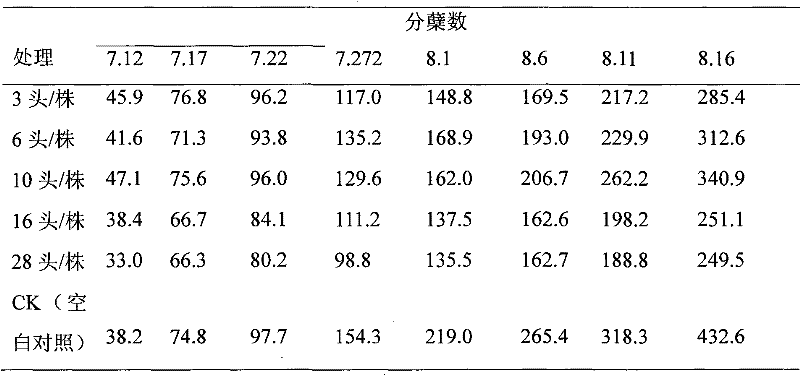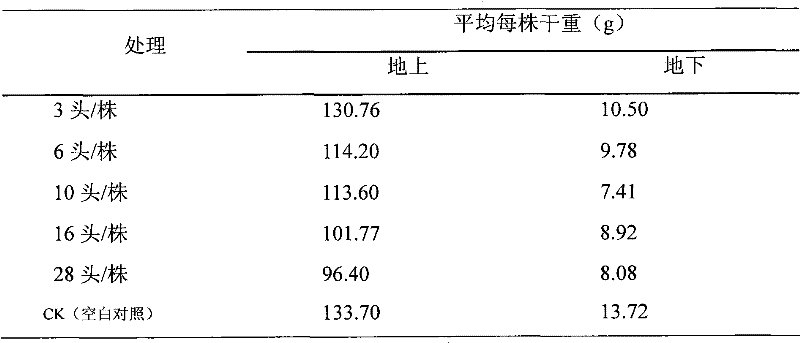Method for artificially raising epiblema strenuana
A technology of ragweed tortrix and ragweed, which is applied in the field of artificial breeding of natural enemy insects, can solve the problem that natural enemies cannot fully play their roles, and achieve the effect of simple and easy to master and less manpower and material resources input
- Summary
- Abstract
- Description
- Claims
- Application Information
AI Technical Summary
Problems solved by technology
Method used
Image
Examples
Embodiment 1
[0038] Embodiment 1: artificially raise ragweed tortrix with the method provided by the invention, its steps are as follows:
[0039] 1) Insect source collection, winter preservation and breaking diapause of ragweed moth
[0040] The ragweed stalks or branches (kept at 30-40cm long) collected in the field from the end of September to the beginning of October 2008 (kept at a length of 30-40 cm) were placed on an indoor insect rack, and the ragweed galls were affected. For winter storage, the storage conditions in winter are as follows: black curtains are drawn indoors for shading, heated with an oil heater, humidified with a humidifier, and maintained at an indoor temperature of 6-10°C and a humidity of 60-70%;
[0041] By mid-March 2009, the ragweed stalks or branches with ragweed tortrix galls were placed in the light conditions of 28°C, 70-75% humidity and light and shade L:D=16:8 to relieve diapause Placed in the room for 25 days to remove the diapause of the ragweed moth ...
Embodiment 2
[0055] Embodiment 2: use method provided by the invention to artificially raise ragweed tortrix, and its steps are as follows:
[0056] 1) Insect source collection, winter preservation and breaking diapause of ragweed moth
[0057] The ragweed stalks or branches (kept at 30-40cm long) collected in the field from the end of September to the beginning of October 2008 (kept at a length of 30-40 cm) were placed on an indoor insect rack, and the ragweed galls were affected. For winter storage, the storage conditions in winter are as follows: black curtains are drawn indoors for shading, heated with an oil heater, humidified with a humidifier, and maintained at an indoor temperature of 6-10°C and a humidity of 60-70%;
[0058] By mid-March 2009, the ragweed stalks or branches with ragweed tortrix galls were placed in the light conditions of 28°C, 75-80% humidity and light and shade L:D=16:8 to relieve diapause Placed in the room for 20 days to remove the diapause of the ragweed mot...
Embodiment 3
[0072] Embodiment 3: artificially raise ragweed tortrix with the method provided by the invention, its steps are as follows:
[0073] 1) Insect source collection, winter preservation and breaking diapause of ragweed moth
[0074] The ragweed stalks or branches (kept at 30-40cm long) collected in the field from the end of September to the beginning of October 2008 (kept at a length of 30-40 cm) were placed on an indoor insect rack, and the ragweed galls were affected. For winter storage, the storage conditions in winter are as follows: black curtains are drawn indoors for shading, heated with an oil heater, humidified with a humidifier, and maintained at an indoor temperature of 6-10°C and a humidity of 60-70%;
[0075] By mid-March 2009, the ragweed stalks or branches with ragweed tortrix galls were placed in the light conditions of 28°C, 80-90% humidity and light and shade L:D=16:8 to relieve diapause Placed in the room for 23 days to remove the diapause of the ragweed moth ...
PUM
 Login to View More
Login to View More Abstract
Description
Claims
Application Information
 Login to View More
Login to View More - R&D
- Intellectual Property
- Life Sciences
- Materials
- Tech Scout
- Unparalleled Data Quality
- Higher Quality Content
- 60% Fewer Hallucinations
Browse by: Latest US Patents, China's latest patents, Technical Efficacy Thesaurus, Application Domain, Technology Topic, Popular Technical Reports.
© 2025 PatSnap. All rights reserved.Legal|Privacy policy|Modern Slavery Act Transparency Statement|Sitemap|About US| Contact US: help@patsnap.com



